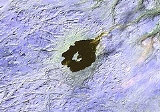
Mistastin crater
Encyclopedia
Mistastin crater is a meteorite
crater
in Labrador
, Canada
which contains the roughly circular Mistastin Lake.
The lake's arcuate central island is interpreted to be the central uplift of the complex crater structure. The target rocks were part of a batholith
composed of adamellite, mangerite
and lenses of anorthosite
. There are abundant shock metamorphic
features exhibited in the rocks of the island. Planar deformation features
, diaplectic glass, melt rocks, and shatter cone
s have been identified.
The lake
is approximately 16 km (9.9 mi) in diameter, while the estimated diameter of the original crater is 28 km (17.4 mi). The age of the crater is estimated to be 36.4 ± 4 million years (Eocene
).
Meteorite
A meteorite is a natural object originating in outer space that survives impact with the Earth's surface. Meteorites can be big or small. Most meteorites derive from small astronomical objects called meteoroids, but they are also sometimes produced by impacts of asteroids...
crater
Impact crater
In the broadest sense, the term impact crater can be applied to any depression, natural or manmade, resulting from the high velocity impact of a projectile with a larger body...
in Labrador
Newfoundland and Labrador
Newfoundland and Labrador is the easternmost province of Canada. Situated in the country's Atlantic region, it incorporates the island of Newfoundland and mainland Labrador with a combined area of . As of April 2011, the province's estimated population is 508,400...
, Canada
Canada
Canada is a North American country consisting of ten provinces and three territories. Located in the northern part of the continent, it extends from the Atlantic Ocean in the east to the Pacific Ocean in the west, and northward into the Arctic Ocean...
which contains the roughly circular Mistastin Lake.
The lake's arcuate central island is interpreted to be the central uplift of the complex crater structure. The target rocks were part of a batholith
Batholith
A batholith is a large emplacement of igneous intrusive rock that forms from cooled magma deep in the Earth's crust...
composed of adamellite, mangerite
Mangerite
Mangerite is a plutonic intrusive igneous rock, that is essentially a hypersthene-bearing monzonite. It often occurs in association with norite, anorthosite, charnockite and rapakivi granite in Proterozoic metamorphic belts....
and lenses of anorthosite
Anorthosite
Anorthosite is a phaneritic, intrusive igneous rock characterized by a predominance of plagioclase feldspar , and a minimal mafic component...
. There are abundant shock metamorphic
Shock metamorphism
Shock metamorphism or impact metamorphism describes the effects of shock-wave related deformation and heating during impact events. The formation of similar features during explosive volcanism is generally discounted due to the lack of metamorphic effects unequivocally associated with explosions...
features exhibited in the rocks of the island. Planar deformation features
Planar deformation features
Planar deformation features, or PDFs, are optically recognizable microscopic features in grains of silicate minerals , consisting of very narrow planes of glassy material arranged in parallel sets that have distinct orientations with respect to the grain's crystal structure.PDFs are only produced...
, diaplectic glass, melt rocks, and shatter cone
Shatter cone
Shatter cones are rare geological features that are only known to form in the bedrock beneath meteorite impact craters or underground nuclear explosions...
s have been identified.
The lake
Lake
A lake is a body of relatively still fresh or salt water of considerable size, localized in a basin, that is surrounded by land. Lakes are inland and not part of the ocean and therefore are distinct from lagoons, and are larger and deeper than ponds. Lakes can be contrasted with rivers or streams,...
is approximately 16 km (9.9 mi) in diameter, while the estimated diameter of the original crater is 28 km (17.4 mi). The age of the crater is estimated to be 36.4 ± 4 million years (Eocene
Eocene
The Eocene Epoch, lasting from about 56 to 34 million years ago , is a major division of the geologic timescale and the second epoch of the Paleogene Period in the Cenozoic Era. The Eocene spans the time from the end of the Palaeocene Epoch to the beginning of the Oligocene Epoch. The start of the...
).
Additional sources
- Currie, K.L. (1968) "Mistastin Lake, Labrador: A new Canadian crater". Nature, v. 220, pp. 776-777.
- Currie, K.L. Larochelle, A. (1969) "A paleomagnetic study of volcanic rocks from Mistastin Lake, Labrador, Canada". Earth and Planetary Science Letters, v. 6, pp. 309-315.
- Currie, K.L. (1971) "Geology of the resurgent cryptoexplosion crater at Mistastin Lake, Labrador". Geological Survey of Canada Bulletin 207, 62 p.
- Currie, K.L. (1971) "The composition of anomalous plagioclase glass and coexisting plagioclase from Mistastin Lake, Labrador, Canada". Mineralogical Magazine, v. 38, pp. 511-517.
- Grieve, R.A.F. (1975) "Petrology and chemistry of the impact melt at Mistastin Lake crater, Labrador". Geological Society of America Bulletin 86, pp. 1617-1629.
- Mak, E.K.C. York, D., Grieve, R.A.F. and Dence, M.R. (1976) "The age of the Mistastin Lake crater, Labrador, Canada". Earth and Planetary Science Letters, v. 31, pp. 345-357.
- Marchand, M. Crocket, J.H. (1977) "Sr isotopes and trace element geochemistry of the impact melt and target rocks at the Mistastin Lake crater, Labrador". Geochimica et Cosmochimica Acta, v. 41, pp. 1487-1495.

